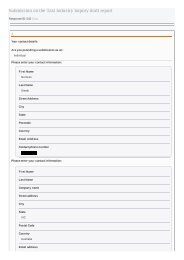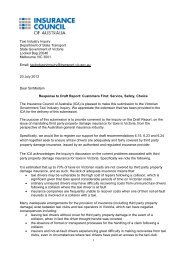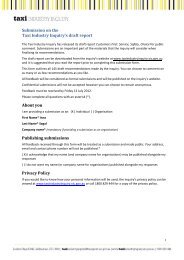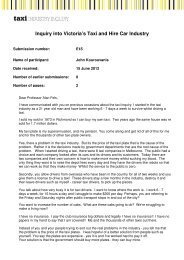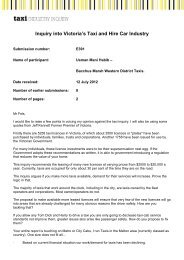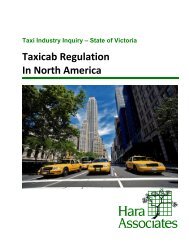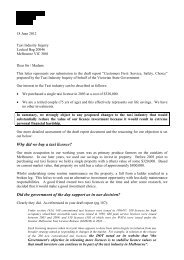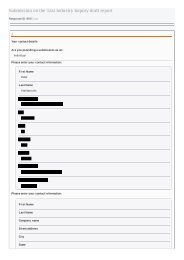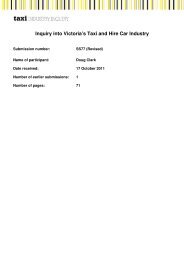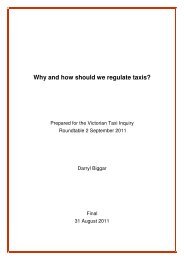Part D â Understanding and improving industry performance (PDF ...
Part D â Understanding and improving industry performance (PDF ...
Part D â Understanding and improving industry performance (PDF ...
Create successful ePaper yourself
Turn your PDF publications into a flip-book with our unique Google optimized e-Paper software.
However, unlike most other goods <strong>and</strong> services, all<br />
electronic payments in Victorian taxis attract a total<br />
‘service fee’ of at least 10 per cent of the total fare (the<br />
metered fare, any flagfall, booking fee, tolls <strong>and</strong> GST<br />
payable). GST is also payable on service fees, which<br />
brings the total surcharge to 11 per cent of the value of<br />
the fare, except when a consumer uses a Cabchargebr<strong>and</strong>ed<br />
card. 1 The surcharge on electronic payments<br />
substantially increases the total cost of taxi travel. For<br />
instance, a passenger paying with a credit card for a<br />
typical trip to Melbourne Airport from the CBD will pay<br />
around $6.00 on top of the total fare.<br />
12.1.1. Submissions <strong>and</strong> consultations<br />
Payment systems in taxis are raised in submissions<br />
by taxi users <strong>and</strong> <strong>industry</strong> participants. Taxi users <strong>and</strong><br />
drivers commonly view the service fee as excessive, anticompetitive<br />
<strong>and</strong> even a cause for anger directed against<br />
taxi drivers:<br />
There is no excuse for this. It is simply anticompetitive<br />
behaviour <strong>and</strong> adds to the cost of<br />
taking a taxi. 2<br />
The fees charged are ‘robbery’ <strong>and</strong> unfairly increase<br />
the price of our service to our customers. 3<br />
…the service fee <strong>and</strong> the GST on service fee charged<br />
by… Cabcharge is outrageous. It really needs to be<br />
reconsidered. 11% extra is good enough to make<br />
passengers angry on driver. 4<br />
The cost to passengers using non-cash payments is<br />
excessive – the st<strong>and</strong>ard 10% plus GST is an<br />
outrageous imposition by a corporation abusing its<br />
monopolistic market power. 5<br />
The unreasonableness of the surcharge is particularly<br />
evident for large organisations that spend substantial<br />
sums of money on taxi travel, including some government<br />
agencies. For example, the Transport Accident<br />
Commission (TAC) spends approximately $4.5 million<br />
each year on taxi travel for its clients. This implies that the<br />
TAC is charged approximately $450,000 in service fees<br />
each year. 6<br />
Cabcharge responded to an information notice issued by<br />
the inquiry about how it sets the level of the surcharge.<br />
Cabcharge maintains that this was the level of fees<br />
generally applying when it first began business <strong>and</strong> is<br />
the level of fees charged by a range of other providers<br />
of like services. However, the inquiry is unable to make<br />
a judgement on the level of fees, as Cabcharge has<br />
provided no data on its costs.<br />
Gange Corporation provided clarification about the<br />
nature of Silver Top Taxi Services Ltd relationship with<br />
Cabcharge <strong>and</strong> the degree of vertical integration of<br />
Silver Top. Gange Corporation noted that Silver Top<br />
did not own any shares in Cabcharge, while Gange<br />
Corporation, its subsidiaries <strong>and</strong> directors each<br />
owned a very small number of shares in Cabcharge<br />
(less than 0.2 per cent of total issued shares). There<br />
are also no common directorships between Gange<br />
Corporation <strong>and</strong> its subsidiaries <strong>and</strong> Cabcharge. 7<br />
Another provider, CabFare, shared information about<br />
the payment systems <strong>industry</strong> <strong>and</strong> its views on areas<br />
needing reform.<br />
12.2. Background<br />
Since the mid-1990s, when the first electronic payment<br />
processors were used in Victorian taxis, the use of<br />
non-cash payment instruments by taxi users has grown<br />
significantly.<br />
While precise figures are unavailable, data from a large<br />
Melbourne operator indicates that, on average, 40 per<br />
cent of taxi fares are paid electronically. This includes credit<br />
<strong>and</strong> debit cards, taxi-specific charge cards <strong>and</strong> vouchers.<br />
Cabcharge’s own published results show strong growth in<br />
the use of bank-issued cards in taxis in Australia over the<br />
past five years, as shown in Figure 12.1.<br />
The inquiry also received comments from taxi operators<br />
who supplied information about their dealings with<br />
payment system providers.<br />
1 Cabcharge chooses to absorb the GST on these transactions, making<br />
the service fee 9.1 per cent<br />
2 Ms Gold, Submission to the Taxi Industry Inquiry, SS31, p.1<br />
3 Keith Murdoch, Submission to the Taxi Industry Inquiry, SS230, p.2<br />
4 Omer Farooq, Submission to the Taxi Industry Inquiry, SS169, p.1<br />
5 Australian Taxi Drivers Association (ATDA), Submission to the Taxi<br />
Industry Inquiry, SS27, p.3<br />
6 Correspondence with the TAC, 30 March 2012<br />
7 Gange Corporation, Submission to the Taxi Industry Inquiry, SS124A, p.3<br />
<strong>Underst<strong>and</strong>ing</strong> <strong>industry</strong> <strong>performance</strong> CUSTOMERS FIRST 251




